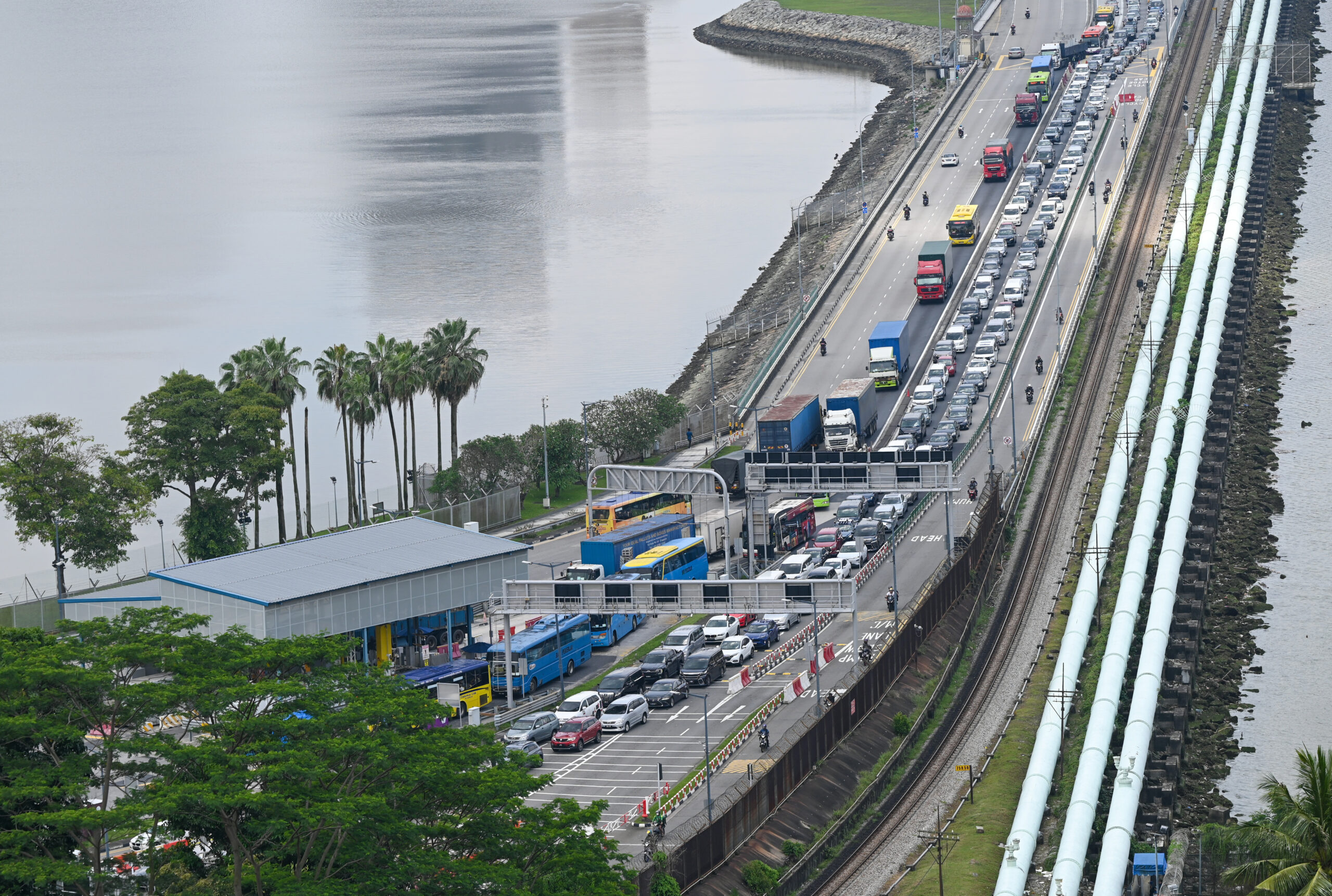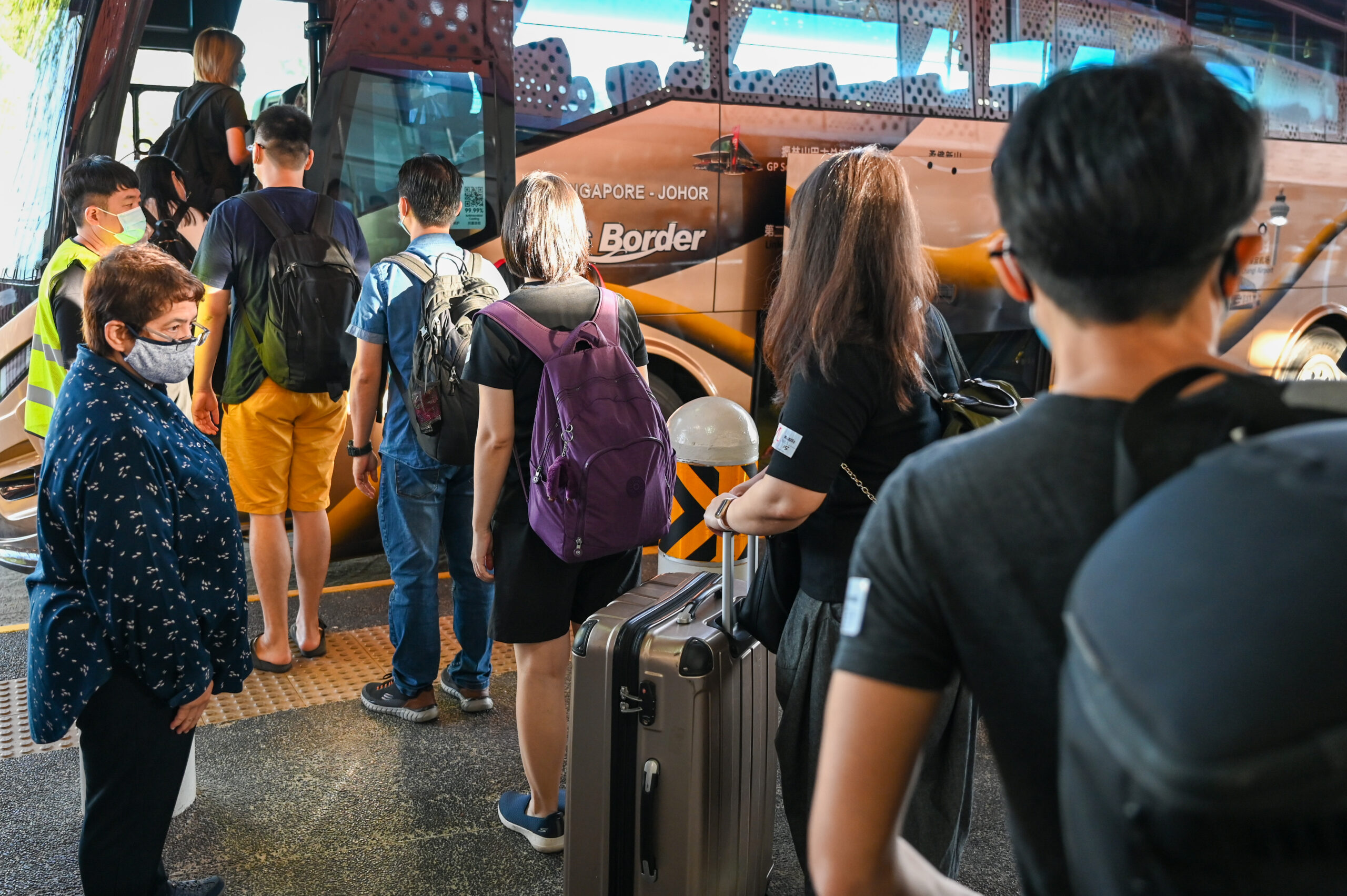It takes five minutes for Emily Ma to leave the country.
Perched on a long bench in Singapore’s Woodlands Station, the slight elegant retiree doesn’t seem in a rush. The close links between her home country and neighbouring Malaysia allows her to build a base across both sides of the border.
A shuttle train leaves 13 times a day from Singapore’s Woodlands station and arrives in the Malaysian city of Johor Bahru just five minutes later. A bus takes one hour, and non-residents are currently allowed to stay in each country for up to 30 days without a visa.
“I go for a holiday, to see friends, or just to relax,” Ma said. “These links are important because [Singapore and Malaysia] used to be one family. In a way, we still are one family.”
Once part of the same country, these neighbours remain close trading partners with increasingly intertwined economies. As ASEAN states deepen their connections through schemes like the bloc’s Single Window customs programme and cross-border QR payments arranged through central bank collaborations, Malaysia and Singapore may soon draw even closer together with a transnational special economic zone between the city-state and the state of Johor
The combined GDP of their two intertwined economies is already predicted to exceed $1 trillion within the next five years, more than a quarter of the total ASEAN bloc. The special zone is still in tentative stages, first proposed unofficially by Malaysia’s Economic Minister Rafizi Ramli in May, but could mark a significant step in the countries’ integration.

While details of what such a collaboration would entail remain scarce there are plans to raise it at an upcoming Malaysian Cabinet meeting before bringing it to the annual meeting of a Malaysia-Singapore joint committee for economic cooperation, expected to be held in mid-July.
“Malaysia and Singapore enjoy strong ties in terms of trade and investment flows, tourism and labour movement,” said M. Niaz Asadullah, a professor of development economics at Monash University Malaysia. “But there is untapped potential for mutual economic gains if Singapore can leverage its close proximity to natural resources rich Malaysia.”
Thousands of Singaporeans cross into Malaysia every day by the 1,056-kilometre rail and motorway causeway that has linked the two over the Johor Strait since 1924. Bus fare for the crossing starts from about $1.48 (SGD 2).
The convenience of travel has created a longstanding symbiotic exchange of labour, trade and people between the two regions. As of 2014, it was estimated that about 5,000 Singaporeans live and work in Johor Bahru. The ringgit’s recent depreciation against the comparatively stable Singaporean dollar has made the cost of living in the Malaysian region comfortable compared to the expensive city-state.
But while more casual travel is a breeze, the closeness for commercial purposes is still marred by long queues, traffic bottlenecks and customs checks. Recent complaints reveal some Singaporean bus passengers spent up to seven hours waiting at the Johor-Bahru customs checkpoint, a delay a special economic zone could ease.

Strengthening inter-ASEAN ties
The announcement of the proposed region comes as part of a concerted push by Malaysian Prime Minister Anwar Ibrahim to strengthen his country’s inter-ASEAN ties and reduce reliance on Western economies.
As its closest neighbour, the city-state is a regional economic hub and a natural trading target for Malaysia.
The two countries have deep historical connections – Singapore was originally part of the Federation of Malaya after the two countries achieved independence from the U.K. but split in 1965. A January meeting with Singaporean leaders secured $4 billion in foreign direct investment from the Lion City.
“[Anwar’s] latest effort to renew bilateral ties with Singapore could be motivated by … a ‘look East’ philosophy,” said Asadullah. “By strengthening economic ties with Singapore, this can help Malaysia accelerate its transition to a high income nation status by 2028.”
For its part, Singapore benefits from the resources and labour available in the Malaysian state, with many Singaporean companies already choosing to locate their assembly and production lines in Johor.

Johor: a cornerstone of trade
Johor’s role as a cornerstone in the regional trade between Singapore and Malaysia has been a longstanding part of both countries’ economic history. In 1988, the border state announced a policy ‘twinning’ with Singapore that led to a 200% increase in investment from its neighbour that same year.
Since then, the relationship between the two has only deepened – especially amidst broader economic recovery efforts after two years of pandemic-related border issues.
“The two-year Singapore lockdown really had an impact on Johor,” said James Chin, professor of Asian studies at the University of Tasmania. “Now people are really looking for new impetus to push this Johor-Singapore growth triangle.”
Another motivating factor of this deepening network of economic relations would be renewable energy, as announced by minister Ramli.
This follows a May announcement to lift a Malaysian ban on renewable energy exports, part of the government’s ambitious aims to double renewable energy capacity by 2050. But the country’s renewable energy sector is still nascent, with coal and natural gas currently meeting 75% of Malaysia’s power demands.
Over the border, Singapore is also trying to boost its renewables with limited success. Experts believe a symbiotic partnership between the neighbours could unlock new potential for both.
“The limited land area is a big challenge for Singapore to develop large-scale renewable energy projects,” explained Kim Jeong Won, research fellow at Energy Studies Institute of National University of Singapore. “Importing renewable electricity through regional power grids can help Singapore’s energy transition and the deployment of low-carbon solutions in the region.”
Professor Asadullah also hopes the new proposed economic region will help meet growing regional demand for energy while encouraging a mutually beneficial trade between Malaysia and Singapore.
“Land and natural resource-poor Singapore is particularly keen to develop a sustainable pan-ASEAN power grid,” she said. “This will not only pave the way for greater bilateral trade in clean energy, it’ll also encourage FDI from Singapore into Malaysia’s renewable energy sector… and overall development of green infrastructure.”
Smoother trade and transactions
The practicalities of how the two countries’ different economies, currencies and markets would interact could raise hurdles to seamless trade within the region. For Asadullah, the success of the economic region would rely on lowering cross-border transaction costs and harmonising labour and environmental standards.
Singapore and Malaysia’s central banks have linked their countries’ smartphone QR systems to facilitate cross-border financial transactions.
“The key challenge is to coordinate the necessary institutional reforms,” said Natalya Ischenko, CEO of Robocash Group, a financial group specialising in providing financial services in Asia and Europe, adding that the effects of the QR developments should be “significantly manifested” in the coming year.
She estimated that cross-border QR payment systems could facilitate trade between the two countries of at least 0.5% and e-commerce in Singapore by at least 2% a month.
“[If so], the foreign trade between Singapore and Malaysia will be between $136.9 billion and $147.3 billion by the end of 2024,” she said.
For Chin, the latest proposed economic tie is a continuation of a history of two countries linked by politics, geography and ambitious economic goals.
“Of course this is good for the region. It is a win-win situation,” he said. “[But] the way to understand the economic relations between Johor and Singapore is that they are tied to each other. Whether they like each other or not, it really doesn’t matter, they have to work together for prosperity.”


